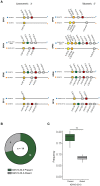Frequent use of IGHV3-30-3 in SARS-CoV-2 neutralizing antibody responses
- PMID: 37041983
- PMCID: PMC7614418
- DOI: 10.3389/fviro.2023.1128253
Frequent use of IGHV3-30-3 in SARS-CoV-2 neutralizing antibody responses
Abstract
The antibody response to SARS-CoV-2 shows biased immunoglobulin heavy chain variable (IGHV) gene usage, allowing definition of genetic signatures for some classes of neutralizing antibodies. We investigated IGHV gene usage frequencies by sorting spike-specific single memory B cells from individuals infected with SARS-CoV-2 early in the pandemic. From two study participants and 703 spikespecific B cells, the most used genes were IGHV1-69, IGHV3-30-3, and IGHV3-30. Here, we focused on the IGHV3-30 group of genes and an IGHV3-30-3-using ultrapotent neutralizing monoclonal antibody, CAB-F52, which displayed broad neutralizing activity also in its germline-reverted form. IGHV3-30-3 is encoded by a region of the IGH locus that is highly variable at both the allelic and structural levels. Using personalized IG genotyping, we found that 4 of 14 study participants lacked the IGHV3-30-3 gene on both chromosomes, raising the question if other, highly similar IGHV genes could substitute for IGHV3-30-3 in persons lacking this gene. In the context of CAB-F52, we found that none of the tested IGHV3-33 alleles, but several IGHV3-30 alleles could substitute for IGHV3-30-3, suggesting functional redundancy between the highly homologous IGHV3-30 and IGHV3-30-3 genes for this antibody.
Keywords: SARS-CoV-2; allelic diversity; antibodies; copy number variation; immunoglobulin germline genes.
Conflict of interest statement
Conflict of interest MC and GKH are founders of ImmuneDiscover Sweden. The remaining authors declare that the research was conducted in the absence of any commercial or financial relationships that could be construed as a potential conflict of interest.
Figures




Similar articles
-
Immunoglobulin germline gene polymorphisms influence the function of SARS-CoV-2 neutralizing antibodies.Immunity. 2023 Jan 10;56(1):193-206.e7. doi: 10.1016/j.immuni.2022.12.005. Epub 2022 Dec 12. Immunity. 2023. PMID: 36574772 Free PMC article.
-
[Development of IgHV family specific nucleic acid vaccine against lymphoma by construction of fusion gene of immunoglobulin heavy chain variable region and cytokine].Zhonghua Yi Xue Za Zhi. 2004 Jan 2;84(1):48-53. Zhonghua Yi Xue Za Zhi. 2004. PMID: 14990159 Chinese.
-
Induction of IGHV3-53 public antibodies with broadly neutralising activity against SARS-CoV-2 including Omicron subvariants in a Delta breakthrough infection case.EBioMedicine. 2024 Nov 1;110:105439. doi: 10.1016/j.ebiom.2024.105439. Online ahead of print. EBioMedicine. 2024. PMID: 39488016
-
B-cell receptor, clinical course and prognosis in chronic lymphocytic leukaemia: the growing saga of the IGHV3 subgroup gene usage.Br J Haematol. 2011 Apr;153(1):3-14. doi: 10.1111/j.1365-2141.2010.08440.x. Epub 2011 Feb 8. Br J Haematol. 2011. PMID: 21303354 Review.
-
Molecular genetic characterization reveals new subsets of mantle cell lymphoma.Leuk Lymphoma. 2008 Jun;49(6):1042-9. doi: 10.1080/10428190801947559. Leuk Lymphoma. 2008. PMID: 18452063 Review.
Cited by
-
Dissecting human monoclonal antibody responses from mRNA- and protein-based XBB.1.5 COVID-19 monovalent vaccines.bioRxiv [Preprint]. 2024 Jul 16:2024.07.15.602781. doi: 10.1101/2024.07.15.602781. bioRxiv. 2024. PMID: 39071292 Free PMC article. Preprint.
References
-
- Ju B, Zhang Q, Ge J, Wang R, Sun J, Ge X, et al. Human neutralizing antibodies elicited by SARS-CoV-2 infection. Nature. 2020;584(7819):115–9. - PubMed
-
- Liu L, Wang P, Nair MS, Yu J, Rapp M, Wang Q, et al. Potent neutralizing antibodies against multiple epitopes on SARS-CoV-2 spike. Nature. 2020;584(7821):450–6. - PubMed
Grants and funding
LinkOut - more resources
Full Text Sources
Research Materials
Miscellaneous
